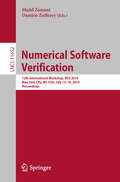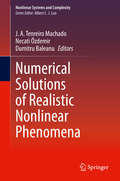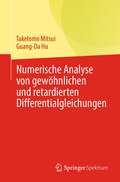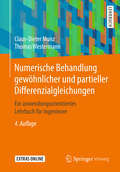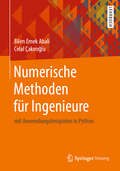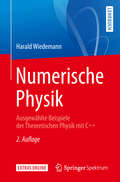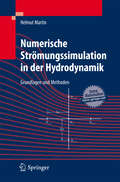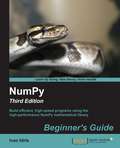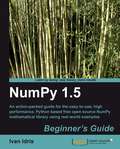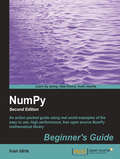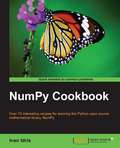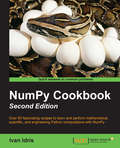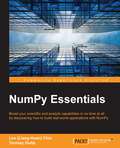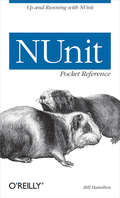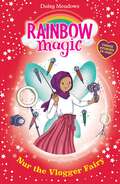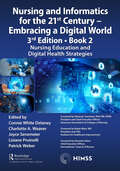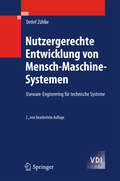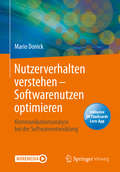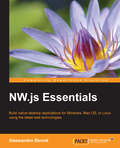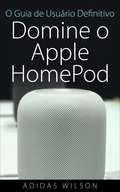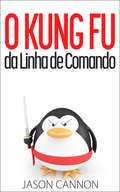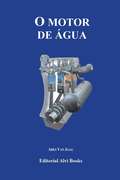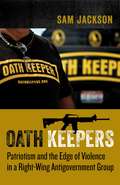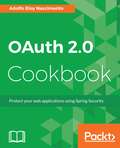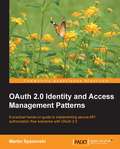- Table View
- List View
Numerical Software Verification: 12th International Workshop, NSV 2019, New York City, NY, USA, July 13–14, 2019, Proceedings (Lecture Notes in Computer Science #11652)
by Majid Zamani Damien ZuffereyThis book constitutes the proceedings of the 12th International Workshop on Numerical Software Verification, NSV 2019, held in New York City, NY, USA, in July 2019 - colocated with the International Conference on Computer Aided Verification, CAV 2019. The 5 full papers presented together with 2 short papers, 3 abstracts of invited talks, and 2 tutorial papers were carefully reviewed and selected from numerous submissions. The NSV 2017 workshop is dedicated to the development of logical and mathematical techniques for the reasoning about programmability and reliability.
Numerical Solutions of Realistic Nonlinear Phenomena (Nonlinear Systems and Complexity #31)
by Dumitru Baleanu J. A. Tenreiro Machado Necati ÖzdemirThis collection covers new aspects of numerical methods in applied mathematics, engineering, and health sciences. It provides recent theoretical developments and new techniques based on optimization theory, partial differential equations (PDEs), mathematical modeling and fractional calculus that can be used to model and understand complex behavior in natural phenomena. Specific topics covered in detail include new numerical methods for nonlinear partial differential equations, global optimization, unconstrained optimization, detection of HIV- Protease, modelling with new fractional operators, analysis of biological models, and stochastic modelling.
Numerische Analyse von gewöhnlichen und retardierten Differentialgleichungen
by Taketomo Mitsui Guang-Da HuDieses Buch dient als prägnantes Lehrbuch für Studenten in einem fortgeschrittenen Undergraduate- oder First-Year-Graduate-Kurs in verschiedenen Disziplinen wie angewandte Mathematik, Steuerung und Ingenieurwesen, die den modernen Standard der numerischen Methoden von gewöhnlichen und verzögerten Differentialgleichungen verstehen wollen. Experten in denselben Bereichen können sich auch über die jüngsten Entwicklungen in der numerischen Analyse solcher Differentialsysteme informieren. Gewöhnliche Differentialgleichungen (ODEs) sind ein starkes mathematisches Werkzeug, um eine Vielzahl von Phänomenen in Wissenschaft und Technik auszudrücken. Neben ihrer eigenen Bedeutung ist eine der mächtigen Richtungen, in die sich ODEs ausdehnen, die Einbeziehung einer unbekannten Funktion mit verzögertem Argument. Dies wird als verzögerte Differentialgleichungen (Delay differential equations, DDEs) bezeichnet, die häufig in der mathematischen Modellierung vonBiologie, Demographie, Epidemiologie und Kontrolltheorie vorkommen. In einigen Fällen kann die Lösung einer Differentialgleichung durch algebraische Kombinationen bekannter mathematischer Funktionen erhalten werden. In vielen praktischen Fällen ist eine solche Lösung jedoch recht schwierig oder nicht verfügbar, und es sind numerische Näherungen erforderlich. Die moderne Entwicklung von Computern beschleunigt die Situation und eröffnet darüber hinaus mehr Möglichkeiten der numerischen Mittel. Die Kenntnis und das Fachwissen über die numerische Lösung von Differentialgleichungen wird nun in weiten Bereichen der Wissenschaft und des Ingenieurwesens vorausgesetzt.Man könnte meinen, dass ein gut organisiertes Softwarepaket wie MATLAB in etwa die gleiche Lösung bietet. In gewisser Weise stimmt das auch, aber man muss bedenken, dass der blinde Einsatz von Softwarepaketen den Benutzer in die Irre führt. Das Wesentliche der numerischen Lösung von Differentialgleichungen muss noch gelernt werden. Das vorliegende Buch soll das Wesentliche der numerischen Lösungen von gewöhnlichen Differentialgleichungen sowie von Verzögerungsdifferentialgleichungen vermitteln. Die Autoren haben insbesondere festgestellt, dass es noch wenige prägnante Lehrbücher über Verzögerungsdifferentialgleichungen gibt, und haben sich dann daran gemacht, die Lücke durch möglichst transparente Beschreibungen zu schließen. Die wichtigsten Algorithmen zur numerischen Lösung sind in diesem Buch klar beschrieben. Auch die Stabilität von Lösungen von ODEs und DDEs ist von entscheidender Bedeutung. Das Buch führt in die asymptotische Stabilität von analytischen und numerischen Lösungen ein und bietet einen praktischen Weg zur Analyse ihrer Stabilität unter Verwendung einer Theorie komplexer Funktionen.
Numerische Behandlung gewöhnlicher und partieller Differenzialgleichungen: Ein anwendungsorientiertes Lehrbuch für Ingenieure
by Claus-Dieter Munz Thomas WestermannDie Autoren vermitteln die Herleitung numerischer Algorithmen zur Lösung von Differenzialgleichungen und geben einen Einblick in die praktische Implementierung. Anhand von Beispielen und Übungsaufgaben mit Problemstellungen aus der Ingenieurspraxis werden Eigenschaften und Einsatzbereiche der verschiedenen Verfahren erläutert. Die beiliegende CD-ROM enthält neben den Lösungswegen auch eine interaktive Version des Buchs. Mithilfe des Computer-Algebra-Systems MAPLE können die beschriebenen Verfahren direkt aus dem Text heraus ausgeführt werden.
Numerische Methoden für Ingenieure: mit Anwendungsbeispielen in Python
by Bilen Emek Abali Celal ÇakıroğluTechnische Systeme werden von Ingenieur*innen modelliert und durch numerische Methoden simuliert. Dieses Lehrbuch bietet eine unkomplizierte Einführung in numerische Methoden, mit zahlreichen, praxisrelevanten Beispielen, die mithilfe der Programmiersprache Python gelöst werden. In ingenieurwissenschaftlichen Studienrichtungen sowie in allen Forschungsprojekten sind numerische Simulationen unumgänglich, geeignete Methoden aber oft schwierig zu begreifen. Hier erklären Ingenieure die mathematischen Grundlagen der numerischen Methoden in sachlicher, dennoch simpler Sprache, mit konkreten Anwendungsbeispielen auf Papier und am Bildschirm. Die Besonderheit in diesem Buch ist, dass nicht nur Modelle der physikalischen Systeme berechnet und experimentelle Daten bearbeitet werden, sondern der Code in Python Zeile für Zeile angegeben und erklärt wird. Über die Autoren: B. E. Abali arbeitet als Dozent an der Technischen Universität Berlin sowie der Türkisch-Deutschen Universität in Istanbul, und hat an der Technischen Universität München, University of California Berkeley in den USA und Ghent University in Belgien geforscht. C. Çakıroğlu ist Dozent an der Türkisch-Deutschen Universität in Istanbul und hat an der Technischen Universität Braunschweig, dem DLR (Deutsches Zentrum für Luft- und Raumfahrt) und der University of Alberta in Kanada geforscht.
Numerische Physik: Ausgewählte Beispiele der Theoretischen Physik mit C++ (Springer-Lehrbuch)
by Harald WiedemannDieses Lehrbuch stellt die Numerische Physik anhand einer Vielzahl von Beispielen aus den Bereichen Mechanik, Elektrodynamik, Optik, Statistischer Physik und Quantenmechanik dar. Der Leser lernt hier nicht nur die wichtigsten numerischen Techniken in der Programmiersprache C++ kennen, sondern erhält auch neue Einblicke in die Physik, die konventionelle Zugänge nicht bieten. Das Werk schließt damit eine Lücke zwischen den Standardlehrbüchern der Theoretischen Physik und denen der reinen Programmierung.Zu jedem der physikalischen Themen gibt es eine kurze Wiederholung des theoretischen Hintergrunds und anschließend werden ausgewählte Beispiele im Detail ausgearbeitet. Übungen am Ende des Kapitels bieten weitere Gelegenheit die Anwendungen des Gelernten zu vertiefen.Das Buch richtet sich vornehmlich an Physikstudierende höherer Semester, die bereits über eine Basis in Theoretischer Physik verfügen und auch Grundkenntnisse in der Programmierung in C++ mitbringen.Auf der Produktseite zum Buch auf springer.com finden sich alle Quelltexte zu den Programmen im Buchtext zum Download. Im Anhang erhalten Sie eine Zusammenstellung und Erläuterung frei verfügbarer Software, die sowohl dem Windows-Anwender als auch dem Linux-Freund alle Werkzeuge an die Hand gibt, die er zur Bearbeitung anspruchsvoller physikalischer Fragestellungen benötigt - von Compilern über numerische Bibliotheken bis hin zu Visualisierungstools.
Numerische Strömungssimulation in der Hydrodynamik
by Helmut MartinDer Band liefert eine Einführung in die numerische Strömungssimulation im Bau- und Wasserwesen. Nach einem Überblick über die Methoden werden in Teil 1 Grundlagen und Grundgleichungen der Strömungsmechanik formuliert. In Teil 2 werden ausgewählte Methoden wie die Finite-Element-Methode, das Galerkin-Verfahren, die Finite-Volumen- und Finite-Element-Methode anhand von Beispielen aus der Hydrodynamik erläutert. Vier Programme, mit denen Beispiele im Buch bearbeitet werden können, stehen Lesern unter http://extras.springer.com zur Verfügung.
NumPy: Beginner's Guide - Third Edition
by Ivan IdrisThis book is for the scientists, engineers, programmers, or analysts looking for a high-quality, open source mathematical library. Knowledge of Python is assumed. Also, some affinity, or at least interest, in mathematics and statistics is required. However, I have provided brief explanations and pointers to learning resources.
NumPy 1.5 Beginner's Guide
by Ivan IdrisThe book is written in beginner's guide style with each aspect of NumPy demonstrated by real world examples. There is appropriate explained code with the required screenshots thrown in for the novice. This book is for the programmer, scientist or engineer, who has basic Python knowledge and would like to be able to do numerical computations with Python.
NumPy Beginner's Guide (Second Edition)
by Ivan IdrisThe book is written in beginner's guide style with each aspect of NumPy demonstrated with real world examples and required screenshots.If you are a programmer, scientist, or engineer who has basic Python knowledge and would like to be able to do numerical computations with Python, this book is for you. No prior knowledge of NumPy is required.
NumPy Cookbook
by Ivan IdrisWritten in Cookbook style, the code examples will take your Numpy skills to the next level. This book will take Python developers with basic Numpy skills to the next level through some practical recipes.
NumPy Cookbook - Second Edition
by Ivan IdrisIf you are a Python developer with some experience of working on scientific, mathematical, and statistical applications and want to gain an expert understanding of NumPy programming in relation to science, math, and finance using practical recipes, then this book is for you.
NumPy Essentials
by Tanmay Dutta Leo Liang-Huan ChinBoost your scientific and analytic capabilities in no time at all by discovering how to build real-world applications with NumPy About This Book * Optimize your Python scripts with powerful NumPy modules * Explore the vast opportunities to build outstanding scientific/ analytical modules by yourself * Packed with rich examples to help you master NumPy arrays and universal functions Who This Book Is For If you are an experienced Python developer who intends to drive your numerical and scientific applications with NumPy, this book is for you. Prior experience or knowledge of working with the Python language is required. What You Will Learn * Manipulate the key attributes and universal functions of NumPy * Utilize matrix and mathematical computation using linear algebra modules * Implement regression and curve fitting for models * Perform time frequency / spectral density analysis using the Fourier Transform modules * Collate with the distutils and setuptools modules used by other Python libraries * Establish Cython with NumPy arrays * Write extension modules for NumPy code using the C API * Build sophisticated data structures using NumPy array with libraries such as Panda and Scikits In Detail In today's world of science and technology, it's all about speed and flexibility. When it comes to scientific computing, NumPy tops the list. NumPy gives you both the speed and high productivity you need. This book will walk you through NumPy using clear, step-by-step examples and just the right amount of theory. We will guide you through wider applications of NumPy in scientific computing and will then focus on the fundamentals of NumPy, including array objects, functions, and matrices, each of them explained with practical examples. You will then learn about different NumPy modules while performing mathematical operations such as calculating the Fourier Transform; solving linear systems of equations, interpolation, extrapolation, regression, and curve fitting; and evaluating integrals and derivatives. We will also introduce you to using Cython with NumPy arrays and writing extension modules for NumPy code using the C API. This book will give you exposure to the vast NumPy library and help you build efficient, high-speed programs using a wide range of mathematical features. Style and approach This quick guide will help you get to grips with the nitty-gritties of NumPy using with practical programming examples. Each topic is explained in both theoretical and practical ways with hands-on examples providing you efficient way of learning and adequate knowledge to support your professional work.
NUnit Pocket Reference
by Bill HamiltonFew .NET developers have the luxury of unlimited code testing once their application is complete, and rushing through the testing process is both problematic and stressful. The open source NUnit framework provides an excellent and efficient way to test and improve .NET code as it's written, saving hundreds of QA hours and headaches. NUnit is one of the most mature and widely-used .NET open source projects even Microsoft uses it internally. NUnit is a unit-testing framework for all .Net languages. Written entirely in C#, NUnit takes advantage of many .NET language features, such as custom attributes and other reflection related capabilities. It automates unit testing and reduces the effort required to frequently test code while developing it. NUint is invaluable for .NET developers in test-driven development under agile methodologies such as Extreme Programming (XP) as well as for developers who use for unit testing for software quality assurance. Unfortunately, some of those valuable hours saved by using NUnit can be wasted trying to master this powerful but under-documented framework Proof that good things come in small packages, the NUnit Pocket Reference is a complete reference to NUnit, filling in the blanks left by the existing documentation and online discussion. It offers developers everything they need to know to install, configure, and use NUnit; the NUnit user interface; and a reference to the NUnit framework classes in a slim but well-organized package. This handy little book even offers practical, real world NUnit examples. And with the NUnit Pocket Reference, IT managers will know to expect when they implement unit testing in their projects. It is the only book you'll need on this popular and practical new open source framework.
Nur the Vlogger Fairy (Rainbow Magic #1154)
by Daisy MeadowsNur the Vlogger Fairy is planning Fairyland's biggest vlogger meet-up ever - Magic Vlog Con! But jealous Jack Frost wants to become a vlogging superstar and has stolen Nur's magical objects. Without them, vloggers can't make fun videos. Nur needs Rachel, Kirsty, Gracie and Khadijah's help to get her enchanted objects back and show Jack Frost that vlogging is for expressing yourself, not becoming famous. Can the fairy friends find Nur's lucky ring light, her cool camera and her magic microphone and save Magic Vlog Con? 'These stories are magic; they turn children into readers!' ReadingZone.comIf you like Rainbow Magic, check out Daisy Meadows' other series: Magic Animal Friends and Unicorn Magic!
Nursing and Informatics for the 21st Century - Embracing a Digital World, 3rd Edition - Book 2: Nursing Education and Digital Health Strategies (HIMSS Book Series)
by Connie White DelaneyNursing Education and Digital Health Strategies explores the current state of health and healthcare education, as well as that of nursing informatics education. These topics include technologies-enabled education for all nurses and interprofessional collaborations from a worldwide perspective. The "New" learning for applied critical thinking will include technology, content, skills versus tools, and the use of "smart" systems for care delivery, the role of critical thinking, and uniqueness of nursing care delivery. Further, how these changes are understood as a paradigm shift that needs to be incorporated along with nursing and healthcare education is emphasized. The effects of technology on human behavior are also explored, addressing human–factors interaction, interdependence of human–computer interaction, and other effects of technology on wellbeing. As part of nursing education, learning from clients/patients to better shape and advance nursing education and scholarship are discussed. Academic–clinical practice partnerships for a digital future, how teams are working together (clinician/teacher) for better healthcare delivery and applied knowledge—including joint appointments (exchange of academia and applied expertise), academic–applied human resources, and interprofessional learning/development—are discussed. This book closes by discussing and using case studies to showcase nursing competencies for the next decade, implications for preparing the healthcare workforce for a digital world, faculty readiness, and the interaction with gaming and simulations. Nursing informatics education, including continuing education beyond academia, i.e., informal education, worldwide, as well as global challenges to support digital world capabilities are described. Hands-on Experiential Delivery and learning-based case studies are also included. Nursing and Informatics for the 21st Century – Embracing a Digital World, 3rd Edition is comprised of four books which can be purchased individually: Book 1: Realizing Digital Health – Bold Challenges and Opportunities for Nursing Book 2: Nursing Education and Digital Health Strategies Book 3: Innovation, Technology, and Applied Informatics for Nurses Book 4: Nursing in an Integrated Digital World that Supports People, Systems, and the Planet
Nutzergerechte Entwicklung von Mensch-Maschine-Systemen
by Detlef ZühlkeDas Buch gibt Entwicklern einen Leitfaden zur nutzergerechten Gestaltung von Mensch-Maschine-Systemen an die Hand. Dabei werden die besonderen Gestaltungsprobleme von Useware-Systemen für internationale Märkte ebenso behandelt wie die Auswahl von Entwicklungstools, Normen und Richtlinien sowie grundlegende Gestaltungsregeln. Wichtige Neuerungen, etwa die modellbasierte Entwicklung von Benutzungsschnittstellen oder zukünftige Interaktionsformen, werden in der Neuauflage anhand von Gestaltungsbeispielen vorgestellt.
Nutzerverhalten verstehen – Softwarenutzen optimieren: Kommunikationsanalyse bei der Softwareentwicklung
by Mario DonickSoftware muss nicht nur technische Definitionen, Standards und Normen erfüllen, sondern von ihren Benutzern auch entsprechend wahrgenommen werden. Nutzer und Käufer erwarten eine bestimmte Leistung, die zu den eigenen Zielen passen muss und es ist Aufgabe der Softwareentwickler, diese Leistung zu liefern.Da es hierbei nie eine vollständige Passung geben kann, entsteht ein Kommunikationsproblem – ein Kommunikationsproblem zwischen Menschen, das noch zu selten ernstgenommen wird. Über bekannte Ansätze hinausgehend zeigt das Buch anhand vieler praxisnaher Beispiele ein Verfahren, mit dem Sie Kommunikationsprobleme während der Entwicklung von Software aufdecken und bearbeiten und mit dem Sie auch nach der Veröffentlichung Ihrer Software Möglichkeiten der Optimierung identifizieren können.Zusätzliche Fragen per App: Laden Sie die Springer Nature Flashcards-App kostenlos herunter und nutzen Sie exklusives Zusatzmaterial, um an weiteren Beispielen zu üben und Ihr Wissen zu prüfen.
NW.js Essentials
by Alessandro BenoitIf you are an experienced Node.js developer who wants to create amazing desktop applications using NW.js, this is the book for you. Prior knowledge of HTML5, jQuery, and CSS is assumed.
O Guia de Usuário Definitivo: Domine o Apple HomePod
by Adidas WilsonDomine o Apple HomePod usando dicas, truques, tutoriais completos, resolvendo problemas e muito mais.
O Kung Fu da Linha de Comando
by Jason Cannon Rafaella C. S. BarrosTorne-se um ninja do Linux com O Kung Fu da Linha de Comando! Você acha que tem que se trancar no porão lendo páginas incompreensíveis por meses a fio para ter habilidades de linha de comando como um ninja? Na verdade, se alguém compartilhasses as dicas, truques e padrões mais poderosos da linha de comando, você economizaria muito tempo. E se você pudesse aprender com alguém que é um guru da linha de comando? E se ele mostrasse os comandos que está usando e por que está usando e como exatamente eles funcionam? E se ele escrevesse tudo isso, para que você pudesse consultar sempre que quisesse? O Kung Fu da Linha de Comando está repleto de muitas dicas e mais de 100 exemplos práticos do mundo real. Não há exemplos teóricos nesse livro. Os exemplos demonstram como solucionar problemas reais e realizar objetivos que valem a pena. As táticas são fáceis de encontrar. Cada capítulo cobre um tópico específico e agrupa dicas e exemplos relacionados juntos. Por exemplo, se você precisa de ajuda extraindo texto de um arquivo, procure no capítulo "Processamento e Manipulação de Textos". Além disso, foi incluído um índice extensivo. Se você quiser encontrar todas as ocorrências de onde um dado comando é usado -- mesmo que não seja o assunto principal -- procure no índice. Eis algumas das coisas que você irá aprender: Como repetir comandos rápida e facilmente no seu histórico da shell Atalhos para obter palavras do seu histórico e usar no seu comando atual Como salvar uma cópia da sua sessão para consulta posterior Como remover linhas em branco e comentários de arquivos Como controlar texto colorido ao usar "pipes" e paginadores Transformando o texto: alteração de caixa, substituição de caracteres, etc. Como extrair blocos de texto de arquivos ou fluxos de entrada Um dica rápida para erros de digitação comuns Como editar arquivos sobre a rede Comparando as diferenças entre
O Motor de Água: Editorial Alvi Books
by Ares Van JaagO "motor de água" é uma invenção infelizmente inventada muitas vezes. O hidrogênio da água é muito abundante, renovável e pode ser usado em países pobres e ricos em energia. O petróleo bruto e o gás natural são recursos energéticos limitados. Mas há muitas pessoas que pensam que certas tecnologias promissoras foram suprimidas por várias potências políticas ou econômicas, geralmente com o propósito de proteger seus investimentos e interesses e, nos extremos já mais absurdos da conspiração ilógica, por motivações sinistras de muito maior alcance. Neste novo trabalho, o versátil compositor e escritor Van Jaag, nos acompanha em uma emocionante jornada através da história desta invenção desconhecida e seus inventores insultados.
Oath Keepers: Patriotism and the Edge of Violence in a Right-Wing Antigovernment Group
by Professor Sam JacksonSince 2008, the American patriot/militia movement—right-wing antigovernment groups who portray themselves as fighting encroaching tyranny—has grown exponentially. Oath Keepers is among the most visible and vocal of these organizations. Formed in 2009, Oath Keepers gained notoriety for its involvement in the Bundy Ranch standoff of 2014 and the Malheur Refuge occupation of 2016. The group gives voice to a recurrent form of American politics: virulent distrust of the government combined with a valorization of violence.Sam Jackson takes readers inside the world of the most prominent antigovernment group in the United States, examining its extensive online presence to discover how it builds support for its political goals and actions. Through an extensive textual analysis of the group’s publications, Jackson explores how Oath Keepers draws on core American political values and pivotal historical moments of conflict and crisis from the Revolutionary War to Waco to Hurricane Katrina to cast its adherents as defenders of liberty. He details how Oath Keepers makes sense of the contemporary United States, how it provides members with models of political behavior, and how it lobbies the wider American public to join the group. The first book-length investigation of the contemporary patriot/militia movement, Oath Keepers sheds new light on what animates groups that pose a growing threat to American security and political culture.
OAuth 2.0 Cookbook
by Adolfo Eloy NascimentoEfficiently integrate OAuth 2.0 to protect your mobile, desktop, Cloud applications and APIs using Spring Security technologies. About This Book • Interact with public OAuth 2.0 protected APIs such as Facebook, LinkedIn and Google. • Use Spring Security and Spring Security OAuth2 to implement your own OAuth 2.0 provider • Learn how to implement OAuth 2.0 native mobile clients for Android applications Who This Book Is For This book targets software engineers and security experts who are looking to develop their skills in API security and OAuth 2.0. Prior programming knowledge and a basic understanding of developing web applications are necessary. As this book's recipes mostly use Spring Security and Spring Security OAuth2, some prior experience with Spring Framework will be helpful. What You Will Learn • Use Redis and relational databases to store issued access tokens and refresh tokens • Access resources protected by the OAuth2 Provider using Spring Security • Implement a web application that dynamically registers itself to the Authorization Server • Improve the safety of your mobile client using dynamic client registration • Protect your Android client with Proof Key for Code Exchange • Protect the Authorization Server from invalid redirection In Detail OAuth 2.0 is a standard protocol for authorization and focuses on client development simplicity while providing specific authorization flows for web applications, desktop applications, mobile phones, and so on. This book also provides useful recipes for solving real-life problems using Spring Security and creating Android applications. The book starts by presenting you how to interact with some public OAuth 2.0 protected APIs such as Facebook, LinkedIn and Google. You will also be able to implement your own OAuth 2.0 provider with Spring Security OAuth2. Next, the book will cover practical scenarios regarding some important OAuth 2.0 profiles such as Dynamic Client Registration, Token Introspection and how to revoke issued access tokens. You will then be introduced to the usage of JWT, OpenID Connect, and how to safely implement native mobile OAuth 2.0 Clients. By the end of this book, you will be able to ensure that both the server and client are protected against common vulnerabilities. Style and approach With the help of real-world examples, this book provides step by step recipes for troubleshooting and extending your API security. The book also helps you with accessing and securing data on mobile, desktop, and cloud apps with OAuth 2.0.
OAuth 2.0 Identity and Access Management Patterns
by Martin SpasovskiThis is a practical and fast-paced guide that gives you all the information you need to start implementing secure OAuth 2.0 implementations in your web applications.OAuth 2.0 Identity and Access Management Patterns is intended for software developers, software architects, and enthusiasts working with the OAuth 2.0 framework. In order to learn and understand the OAuth 2.0 grant flow, it is assumed that you have some basic knowledge of HTTP communication. For the practical examples, basic knowledge of HTML templating, programming languages, and executing commands in the command line terminal is assumed.
